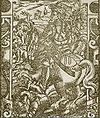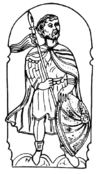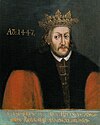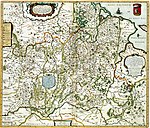List of Lithuanian monarchs
| Monarchy of Lithuania | |
|---|---|
 | |
 King Mindaugas | |
| Details | |
| Style | His/Her Majesty[3] |
| First monarch | Mindaugas I[1] |
| Last monarch | Stanisław II August[2] |
| Formation | 1253 |
| Abolition | 1795 |
| Residence | Mindaugas' Castle, Voruta (1253−1263) Gediminas' Castle, Vilnius (late 13th century−late 15th century) Palace of the Grand Dukes of Lithuania, Vilnius (late 15th century−1665) |
| Appointer | Hereditary (1253–1574) Szlachta (1574–1795) Hereditary (1918) |
| Pretender(s) | Prince Inigo, Duke of Urach (disputed) |
The monarchy of Lithuania concerned the monarchical head of state of Lithuania, which was established as an absolute and hereditary monarchy. Throughout Lithuania's history there were three ducal dynasties that managed to stay in power—House of Mindaugas, House of Gediminas, and House of Jagiellon. Despite this, the one and only King of Lithuania who has ever been crowned was King Mindaugas I,[4][5] although there were two more instances of royal nobles who were not officially crowned due to unfortunate political circumstances, but de jure received recognition abroad as kings of Lithuania from the pope or the Holy Roman emperor—Vytautas the Great by Sigismund of Luxembourg[6] and Mindaugas II by Pope Benedict XV,[7] respectively.[6] Others were seen as kings of Lithuania even though they had only considered it and never took further action to claim the throne, as in the case of Gediminas who was recognised as King of Lithuania by Pope John XXII.[8] The hereditary monarchy in Lithuania was first established in the 13th century during the reign of Mindaugas I and officially re-established as a constitutional monarchy on 11 July 1918, only to be abandoned soon afterwards on 2 November 1918.
Lithuania in the present day is a representative democracy in a semi-presidential system based on popular sovereignty, as defined in the current Constitution of Lithuania, and has no monarchy.
List of monarchs of Lithuania
House of Mindaugas (1236–1267)
| Name | Portrait | Birth | Marriage(s) | Death | Claim |
|---|---|---|---|---|---|
| King Mindaugas 1236 – 1253 (as Grand Duke) 1253 – 1263 (as King) |
 |
c. 1203 Son of mythological Ringaudas |
(1) NN, sister of Morta 2 children (2) Morta 2 children |
1263 Aglona Assassinated by Treniota and Daumantas Aged about 60 |
Right of conquest Son of mythological Ringaudas |
| Grand Duke Treniota 1263 – 1264 |
 |
Unknown Son of NN, Mindaugas' sister and Vykintas |
Unknown 1 child |
1264 Murdered by servants loyal to Mindaugas' son Vaišvilkas |
Right of conquest Nephew of Mindaugas |
| Grand Duke Vaišvilkas Laurušas 1264 – 1267 |
 |
Unknown Son of Mindaugas and Morta |
Unmarried and childless |
1268 Was murdered by Leo I of Galicia |
Right of conquest Son of Mindaugas |
House of Monomakh (1267–1269)
| Name | Portrait | Birth | Marriage(s) | Death | Claim |
|---|---|---|---|---|---|
| Grand Duke Shvarn Lithuanian: Švarnas 1267 – 1269 |
c. 1230 Halych Son of Daniel of Galicia |
NN, daughter of Mindaugas No children |
c. 1269 Kholm Aged about 39 |
Offered by Vaišvilkas Brother-in-law of Vaišvilkas |
House of Mindaugas (1269–1285)
| Name | Portrait | Birth | Marriage(s) | Death | Claim |
|---|---|---|---|---|---|
| Grand Duke Traidenis 1270 – 1282 |
 |
1220 | Ona of Masovia 1 child |
1282 Kernavė Aged 62 |
Right of conquest Possibly a relative of Mindaugas |
| Grand Duke Daumantas 1282 – 1285 |
Unknown | Unknown | 3 March 1285 Died in a battle by Tver |
Possibly a son of Mindaugas |
House of Gediminas (1285–1440)
| Name | Portrait | Arms | Birth | Marriage(s) | Death | Claim |
|---|---|---|---|---|---|---|
| Grand Duke Butigeidis 1285 – 1291 |
None known | Unknown Son of Skalmantas (?) |
Unknown | 1291 | Possibly a relative of Daumantas | |
| Grand Duke Butvydas 1291 – 1295 |
None known | Unknown Son of Skalmantas (?) |
Unknown | c. 1294–1295 | Brother of Butigeidis | |
| Grand Duke Vytenis 1295 – 1316 |
 |
None known | 1260 Son of Butvydas |
Vikinda 1 child |
1316 Aged 56 |
Son of Butvydas |
| Grand Duke Gediminas 1316 – 1341 |
 |
None known | c. 1275 Son of Butvydas |
Jaunė 13 children |
c. 1341 Raudonė Aged about 66 |
Son of Butvydas |
| Grand Duke Jaunutis 1341 – 1345 |
 |
None known | c. 1306−1309 Son of Gediminas and Jaunė |
Unknown 3 children |
c. 1366 Aged 57−60 |
Son of Gediminas |
| Grand Duke (Diarchy with Kęstutis) Algirdas 1345 – 1377 |
 |
 |
c. 1296 Son of Gediminas and Jaunė |
(1) Maria of Vitebsk 6 children (2) Uliana of Tver 8 children |
c. 1377 Maišiagala Aged about 81 |
Right of conquest Son of Gediminas |
| Grand Duke (Diarchy with Kęstutis) Jogaila Algirdaitis May 1377 – August 1381 |
 |
 |
c. 1352−1362 Vilnius Son of Algirdas and Uliana of Tver |
(1) Jadwiga of Poland No children (2) Anna of Cilli 1 child (3) Elizabeth Granowska No children (4) Sophia of Halshany 2 children |
1 June 1434 Gródek Jagielloński Aged 72−82 |
Son of Algirdas |
| Grand Duke Kęstutis 1381 – 1382 |
 |
 |
c. 1297 Senieji Trakai Son of Gediminas and Jaunė |
Birutė 3 children |
1382 Kreva Murdered by the order of Jogaila while imprisoned Aged 84–85 |
Right of conquest Son of Gediminas |
| Grand Duke Jogaila Algirdaitis 3 August 1382 – 1 June 1434 (51 years, 302 days) |
 |
 |
c. 1352−1362 Vilnius Son of Algirdas and Uliana of Tver |
(1) Jadwiga of Poland No children (2) Anna of Cilli 1 child (3) Elizabeth Granowska No children (4) Sophia of Halshany 2 children |
1 June 1434 Gródek Jagielloński Aged 72−82 |
Right of conquest Son of Algirdas |
| Act of Kreva signed in 1385 Poland and Lithuania de jure are ruled by one monarch but remain to be separate states. | ||||||
| King of Poland and Grand Duke Jogaila Algirdaitis 3 August 1382 – 1 June 1434 (51 years, 302 days) |
 |
 |
c. 1352−1362 Vilnius Son of Algirdas and Uliana of Tver |
(1) Jadwiga of Poland No children (2) Anna of Cilli 1 child (3) Elizabeth Granowska No children (4) Sophia of Halshany 2 children |
1 June 1434 Gródek Jagielloński Aged 72−82 |
Son of Algirdas |
| Grand Duke Skirgaila 1386 – 1392 |
 |
 |
c. 1353–1354 Vilnius Son of Algirdas and Uliana of Tver |
Unmarried and childless |
11 January 1397 Kyiv Possibly poisoned by the order of the Russian Orthodox priests Aged 43−44 |
Offered by Jogaila Son of Algirdas |
| Astrava Agreement signed in 1392 Following the Lithuanian Civil War, Skirgaila is replaced by Vytautas. The latter and their successors de jure act as regents of the King of Poland until 1440. | ||||||
| Grand Duke King-elect of Lithuania Vytautas Vytautas the Great 4 August 1392 – 27 October 1430 (38 years, 84 days) |
 |
 |
c. 1350 Senieji Trakai Son of Kęstutis and Birutė |
(1) Anna 1 child (2) Uliana Olshanska No children |
27 October 1430 Trakai Aged about 80 |
Offered by Jogaila Son of Kęstutis |
| Grand Duke Švitrigaila October 1430 – 1 August 1432 |
 |
 |
Before 1370 Vilnius Son of Algirdas and Uliana of Tver |
Anna of Tver 1 child |
10 February 1452 Lutsk Aged about 82 |
Son of Algirdas |
| Grand Duke Sigismund Kęstutaitis Lithuanian: Žygimantas Kęstutaitis 1432 – 1440 |
 |
 |
1365 Trakai Son of Kęstutis and Birutė |
Unknown 1 child |
20 March 1440 Trakai Murdered by supporters of Švitrigaila Aged 75 |
Son of Kęstutis |
House of Jagiellon (1440–1569)
| Name | Portrait | Arms | Birth | Marriage(s) | Death | Claim |
|---|---|---|---|---|---|---|
| King of Poland and Grand Duke Casimir IV Jagiellon Lithuanian: Kazimieras Jogailaitis 29 June 1440 – 7 June 1492 (51 years, 344 days) |
 |
 |
30 November 1427 Kraków Son of Jogaila Algirdaitis and Sophia of Halshany |
Elisabeth of Austria 12 children |
7 June 1492 Old Grodno Castle Aged 64 |
Son of Jogaila |
| King of Poland and Grand Duke Alexander Jagiellon Lithuanian: Aleksandras Jogailaitis 30 July 1492 – 19 August 1506 (14 years, 20 days) |
 |
 |
5 August 1461 Kraków Son of Kazimieras Jogailaitis and Elisabeth of Austria |
Helena of Moscow No children |
19 August 1506 Vilnius Aged 45 |
Son of Casimir IV Jagiellon |
| King of Poland and Grand Duke Sigismund I Sigismund I the Old Lithuanian: Žygimantas Senasis 8 December 1506 – 1 April 1548 (41 years, 115 days) |
 |
 |
1 January 1467 Kozienice Son of Kazimieras Jogailaitis and Elisabeth of Austria |
(1) Barbara Zápolya 2 children (2) Bona Sforza 6 children |
1 April 1548 Kraków Aged 81 |
Son of Casimir IV Jagiellon |
| King of Poland and Grand Duke Sigismund II Augustus Lithuanian: Žygimantas Augustas 1 April 1548 – 7 July 1572 (24 years, 97 days) |
 |
 |
1 August 1520 Kraków Son of Žygimantas the Old and Bona Sforza |
(1) Elisabeth of Austria No children (2) Barbara Radziwiłł No children (3) Catherine of Austria No children |
7 July 1572 Knyszyn Aged 51 |
Son of Sigismund I |
| Union of Lublin signed in 1569 Poland and Lithuania are united into a single Commonwealth. | ||||||
House of Urach (1918)
| Name | Portrait | Arms | Birth | Marriage(s) | Death | Claim |
|---|---|---|---|---|---|---|
| King-elect Mindaugas II July 11, 1918 – November 2, 1918 (115 days) |
 |
 |
30 May 1864 Monaco Son of Wilhelm, 1st Duke of Urach and Princess Florestine of Monaco |
(1) Duchess Amalie in Bavaria 9 children (2) Princess Wiltrud of Bavaria No children |
24 March 1928 Rapallo Aged 63 |
De jure restoration Offered by the Lithuanian Council Offer withdrawn |
Timeline of Lithuanian monarchs

Union of Lublin
In 1564, King of Poland and Grand Duke of Lithuania Sigismund II Augustus renounced his rights to the hereditary Lithuanian throne—the separate inauguration ceremony and insignia of the Grand Duke of Lithuania were abolished. On July 1 1569, Sigismund II Augustus united both of the countries into a single bi-federation, known as the Polish–Lithuanian Commonwealth, which had existed for the next 226 years. The Union included constitutional changes such as creating a formal elective monarchy, which would simultaneously reign over both parties.[9] Following the death of Sigismund II in 1572, the title "Grand Duke of Lithuania" was merged with the Polish Crown on accesssion to the throne, thus losing its former institutional significance. During the Deluge of the Second Northern War, the Union temporarily disintegrated in 1655 when the magnates of the Grand Dutchy of Lithuania de jure signed the Union of Kėdainiai with the Swedish Empire.[10] However, it was never implemented and short-lived due to Sweden losing the war.[10] The Commonwealth permanently ceased to exist in 1795, following its third partition by the neighbouring powers, Prussia, Russia and Austria. Following the partitions, the lands of ethnic Lithuania were divided—Lithuania proper became a part of the Russian Empire while Sudovia became a part of the Kingdom of Prussia.
| History of Lithuania |
|---|
 |
| Chronology |
|
|
Titles
King
The full title of the Lithuanian king from 1253 to 1263 was:[11]
In Lithuanian: Iš Dievo malonės, Lietuvos karalius
In Latin: Dei Gratia Rex Lettowiae
In English: By the Grace of God, King of the Lithuania
As the territory of Lithuania expanded eastwards, other king-titled grand dukes who ruled the country adopted similar titles for introducing themselves abroad. For instance, Grand Duke of Lithuania Vytenis was sometimes regarded as Rex Lethowinorum (King of Lithuanians) while his successor Gediminas took the Latin title of Rex Lithuanorum et Multorum Ruthenorum (King of Lithuanians and many Ruthenians).[12][13][14][15] Teutonic Knights referred to Algirdas and his wife Uliana as "Grand King of Lithuania" and "Grand Queen of Lithuania".[16]
Grand Duke
Officially, the title of Grand Duke of Lithuania was introduced after the Pact of Horodło in 1413.[16] Until then, previous monarchs were called by different titles, including kings. This was because in Lithuania, unlike in the majority of other European monarchies, the Grand Duke was a sovereign monarch who was accountable to no one, thus de facto king.[16] The full title of the Grand Duke of Lithuania was:[17]
In Lithuanian: Lietuvos didysis kunigaikštis
In Latin: Magnus Dux Lithuaniae
In Ruthenian: Великій Кнѧзь Литовскій[citation needed]
In English: Grand Duke of the Lithuania
Following the Act of Krėva with Poland in 1385, the full Latin title was changed to Dei Gratia Rex Poloniae Magnus Dux Lithuaniae (By the Grace of God, King of Poland and Grand Duke of Lithuania).
History of the monarchy
Kingdom of Lithuania under Mindaugas I
As the conquests of Prussia by the Teutonic Order and of Livonia by the Livonian Brothers were coming to an end, both Catholic religious orders began posing an existential threat to then-pagan Lithuania. In response, Duke Mindaugas, who by then had managed to strengthen his grip in various Baltic and Slavic lands, sought to consolidate power and unite Lithuania into one political entity, convert to Christianity, and become king.[18] In 1250 or 1251, he was baptised as a Roman Catholic. In 1253, probably in Vilnius or Novogrudok,[6] he and his wife Morta were crowned King and Queen, thus establishing a short-lived alliance with the Livonian Order. This laid the basis for the international recongnition of the newly created Kingdom of Lithuania as a Western country.
Attempts of coronation in the Grand Dutchy of Lithuania
The ruler of the Grand Duchy of Lithuania Vytautas the Great was widely considered to be King of Lithuania by the European leaders and Lithuanian nobles of the time.[19] Some historical documents suggest that at the time of signing the Treaty of Salynas in 1398, Lithuanian nobles had acknowledged Vytautas as their King as a symbolic declaration of allegiance.[20] Vytautas himself sought to officially establish his reign by coronation at least three times.[6] However, all three attempts were unsuccessful because the political situation was much more complicated—by this point the Grand Dutchy of Lithuania and the Kingdom of Poland were under a joint rule of the Grand Duke of Lithuania and King of Poland Jogaila (Władysław II Jagiełło) with the Crown being in Kraków, Poland. As a consequence, the idea of a fully-fledged Lithuanian monarchy as well as Poland losing its influence over its neighbour was met with fierce resistance from the Polish nobles.[6] The first time coronation was planned on 8 September, 1430, but after one of the delegations that transported the crown learned that the first delegation was robbed on its way to Lithuania, they returned to Nuremberg. In the same year of October, Vytautas up until his death had planned his coronation at least two more times but with no success.[6]

Kingdom of Lithuania (1918) de jure under Mindaugas II
During the First World War, the German Empire wanted Lithuania proper to be annexed and become a part of either Prussia or Saxony,[21] which for 123 years remained to be a part of the Russian Empire following the Third Partition of the Polish−Lithuanian Commonwealth in 1795. In an attempt to avoid becoming a province but remain on good terms with Germany, the Council of Lithuania decided to establish a separate constitutional monarchy with Wilhelm von Urach as King with his residence being in Verkiai Palace. According to the twelve-point document resembling the rudiments of a Constitution, the Kingdom of Lithuania was supposed to have had a bicameral legislature with a representative role of the monarch. Wilhelm von Urach was also presented with conditions such as adopting the title of Mindaugas II, letting his children to a Lithuanian school, only appointing courtiers, ministers and other high-ranking public officials who are Lithuanian citizens and speak the country's official language as well as not leaving the state for more than two months per year without the permission of the government. However, as the war was coming to an end, it became clear that Germany would lose the war. On October 5, 1918, in the Reichstag the new Chancellor of Germany Maximilian of Baden accounced that his state acknowledged the right of nations to self-determination and supported their efforts of becoming independent countries.[22] Soon afterwards, Germany expressed its official support for the independence of Lithuania.[22] Furthermore, the diplomats of France had also unambiguously proclaimed to the Council of Lithuania and the Parliament that having a monarch of German descent would be seen as unacceptable.[23] On November 2, 1918, as it became apparent that King-elect Mindaugas himself was hesitant to arrive in Lithuania for his coronation due to political unrest, the Council decided to abandon the idea of being a satellite monarchy and establish a fully independent republic instead.
Monarchism in present-day Lithuania
Although currently there are no monarchist parties in modern Lithuania, there is a monarchist movement, which is in favor of re-establishing the short-lived monarchy of 1918.[24] The movement alongside the Lithuanian Royal Union of Nobility believe that the current Lithuanian state did not undergo all of the complicated and necessary procedures to truly abolish the Lithuanian monarchy.[25] According to the senate marshal of the organization "Palace of the Kingdom of Lithuania", Stanislovas Švedarauskas:
Can we present the specific date when the Kingdom of Lithuania of the Middle Ages ceased to exist and when did the Lithuanian 20th-century constitutional monarchy end? In the words of historians, when Mindaugas I died in 1263, the Kingdom had disappeared as well. However, after almost 100 years, in the 14th century, Gediminas would send his letters proclaiming to be "King of Lithuanians and many Ruthenians." In November 1918, the State Council left the question of Mindaugas II to the Constituent Assembly. And while it is true that the latter declared Lithuania to be a democratic republic on May 15, 1920, I have never heard of the Constituent Assembly officially denouncing the State Council's declaration of July 11, 1918, which called to create a constitutional monarchy in Lithuania and invite Mindaugas II to take his throne.[25]
"For Lithuania it is necessary to restore the monarchical institution, which would unite the nation and be a standard of Western welfare in its highest quality. The constitutional monarchy can make Lithuania a welfare state and save the country from a deep moral crisis," he added.[26] However, political commentator Česlovas Iškauskas has responded to such claims, by saying:
In 1918, Germany exerted great influence. But now the idea of re-establishing the constitutional monarchy as well as the activities of the "Palace of the Kingdom of Lithuania" to me seems like a game when you have nothing better to do. At the moment Lithuania has much more important issues—it needs to think how to withstand current threats, not about a new monarchy.[26]
Prince Inigo von Urach, the grandson of Wilhelm von Urach (Mindaugas II), claims that according to Almanach de Gotha he remains to be the rightful claimant to the Lithuanian throne[27] and is willing to become King of Lithuania, if the nation wants him to. To quote him from an interview for LRT, "It's not my thing to decide it [the idea of officially being crowned King], that's the thing of the population here, of the citizens of Lithuania. It's not my thing [to decide]. But I promise—if they want me, I would be ready for this job."[24][28] He also mentioned that Wilhelm von Urach expressed his will in his Testament of "keeping the claim of the throne" of Lithuania as well as Monaco.[28]
References
- ^ As King of Lithuania
- ^ As Grand Duke of Lithuania
- ^ Only formally held by King Mindaugas I and King-elect Mindaugas II.
- ^ Sužiedėlis, Simas, ed. (1970–1978). "Mindaugas". Encyclopedia Lituanica. Vol. III. Boston, Massachusetts: Juozas Kapočius. pp. 538–543. LCC 74-114275.
- ^ Vauchez, Andre; Richard Barrie Dobson; Adrian Walford; Michael Lapidge (2000). Encyclopedia of the Middle Ages. Routledge. p. 855. ISBN 1-57958-282-6.
- ^ a b c d e f Nadveckė, Ineta (6 July 2019) Trys Lietuvos karaliai: vienas tikras, vienas nelabai ir vienas beveik LRT.
- ^ Stuttgart archives, HStA. GU 117, file 847: copy of letter from Benedict XV dated 24 July 1918.
- ^ Gediminas(in Lithuanian). Visuotinė lietuvių enciklopedija.
- ^ Norman Davies, God's Playground: A History of Poland in Two Volumes, Oxford University Press, p.153. Two Podlasian officers were deprived of their lands and offices.
- ^ a b Frost (2000), p. 168
- ^ ''Dalijamės sielos džiaugsmu, tautine didybe ir sveikiname visus bendrapiliečius su Valstybės diena – Lietuvos karaliaus Mindaugo karūnavimo iškilmėmis!'' (in Lithuanian). Lietuvos vyriausiasis administracinis teismas.
- ^ Patackas, Algirdas (2018) ''Vytautas Didysis – Rex electus?'' (in Lithuanian) Lrytas.lt.
- ^ Gedimino laiškai [Letters of Gediminas] (PDF) (in Lithuanian). Vilnius: Vilnius University, Institute of Lithuanian Literature and Folklore. p. 2. Retrieved 30 May 2021.
- ^ Reading the Middle Ages, Volume II: From c.900 to c.1500, Third Edition
- ^ Making a Great Ruler: Grand Duke Vytautas of Lithuania
- ^ a b c Savukynas, Virginijus (2 June 2019) Kas buvo mūsų valdovai – karaliai ar kunigaikščiai? (in Lithuanian) LRT.
- ^ ALEXANDER * MAGNUS DUX LITHUANIAE Kuzma Art.
- ^ Kiaupa, Zigmantas; Jūratė Kiaupienė; Albinas Kunevičius (2000) [1995]. The History of Lithuania Before 1795 (English ed.). Vilnius: Lithuanian Institute of History. pp. 43–127. ISBN 9986-810-13-2.
- ^ Dr Leikis, Algimantas (10 November 2014) Urachas – Mindaugas II: popierinis Lietuvos karalius? (in Lithuanian) komentaras.lt.
- ^ Cibulskis, Gediminas (8 September 2010) Nekarūnuotas Lietuvos karalius Vytautas (in Lithuanian) 15min.
- ^ Lietuvos Taryba ir vokiečių okupacinė valdžia 1918 m. p. 11
- ^ a b Skirius, Juozas. Gimtoji isitorija [Native History] (in Lithuanian). Emokykla. Retrieved 10 May, 2022.
- ^ Bukaitė, Vilma (October 2, 2019) Svaigi Antano Smetonos karjera: nuo banko darbuotojo iki prezidento (in Lithuanian). Lrytas.lt.
- ^ a b Jakilaitis, E. (2018) ''Paskelbtojo karaliaus Mindaugo II anūkas: monarchija Lietuvai būtų pigiau ir naudingiau'' (in Lithuanian). Delfi.
- ^ a b Giedraitis, Rimantas (7 July 2012) ''Turėtume savo karalių, nereikėtų varvinti seilės į svetimus?'' (in Lithuanian) 15min.
- ^ a b Kontrimavičiūtė, Inga (September 19, 2012). Lietuvos karalystė – ne tuščia fantazija? (in Lithuanian). Delfi.
- ^ Salvatore Ferdinando Antonio Caputo. ''The Monarchy in Lithuania''
- ^ a b Dėmesio centre. Karaliaus anūkas Inigo von Urachas. LRT. Archived from the original on 3 March 2018.
